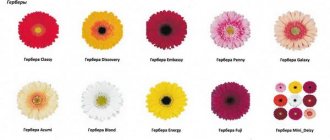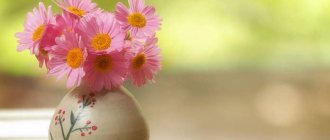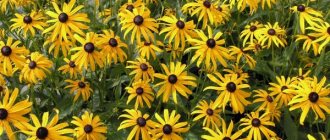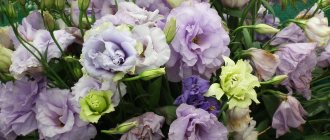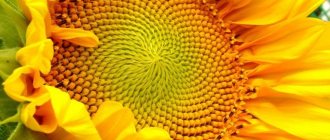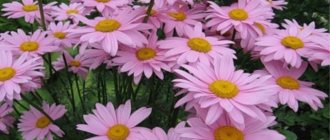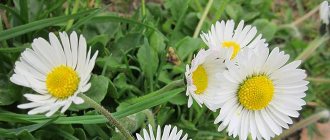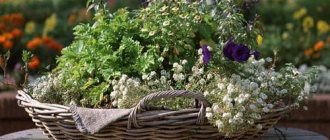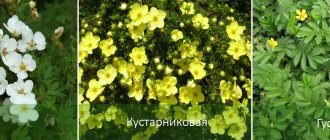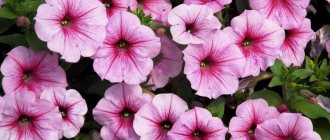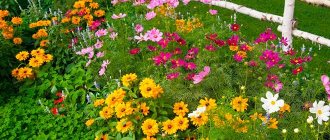A brief description of chamomile
Chamomile is a botanical genus that belongs to the vast family Asteraceae, or Asteraceae, of the dicotyledonous class. The family unites more than 32 thousand species. Flowers similar to daisies can be seen in other members of the family. It includes such genera as aster, doronicum, gerbera, pyrethrum, osteospermum, umbilical, three-ribbed, chrysanthemum, nivyannik.
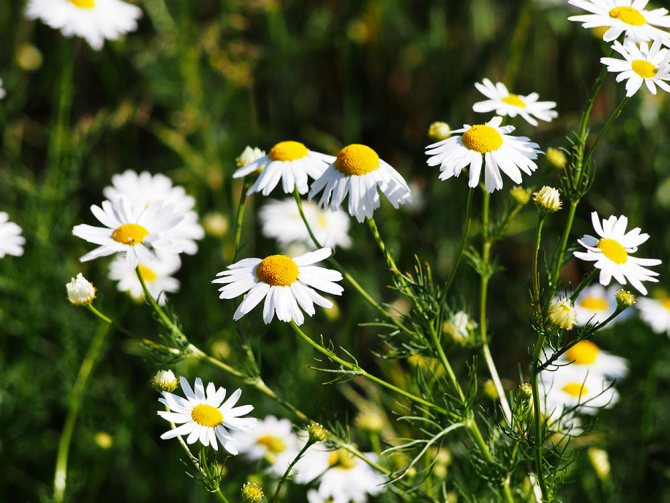
Fragrant chamomile
A distinctive feature of the representatives of the Aster family is the inflorescence. This type is called a "basket", formed by a flat, convex or concave receptacle on which the petals sit tightly. Inflorescence pattern: the receptacle is often surrounded by a wrapper and a calyx formed by one or more rows of bracts. In the case of chamomile, which is familiar to us, small tubular flowers with five stamens form a yellow center, and the common calyx forms the white petals of the outermost reed flowers.
All flowers, like chamomile, have a specific inflorescence appearance with small flowers in, and brightly colored petals along the edge.
Majors
Despite their "military" common name, these herbaceous plants from the genus Compositae characterized by variegated juicy flowers of large size and endurance. Depending on the variety, they can be of different tones, simple, semi-double or terry. Thanks to breeders, varieties with low stems (up to 30 cm), medium (up to half a meter) and high (up to 1 m) appeared on sale.
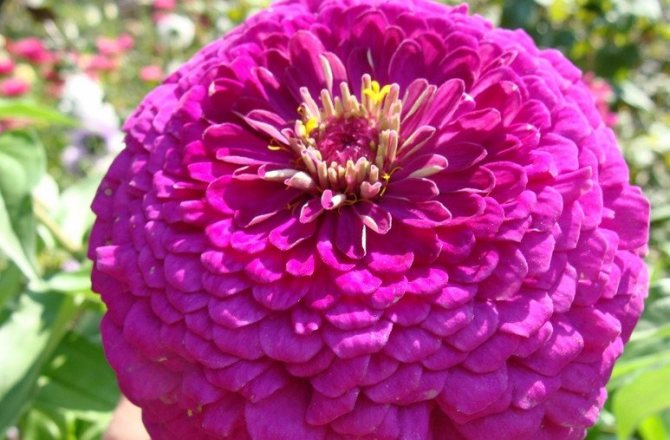

Did you know? The usual majors in the State Register are designated as "zinnias". The flowers received this name in honor of their discoverer, Professor Ivan Tsinna. It was he who brought the seeds of a beautiful plant to Europe from North America.
In the wild, majors form chaotic shrubs with white, pink, red, yellow, purple, burgundy, and purple flowers. In the cultivated version, it is a long-flowering annual that keeps the bouquet fresh for weeks.
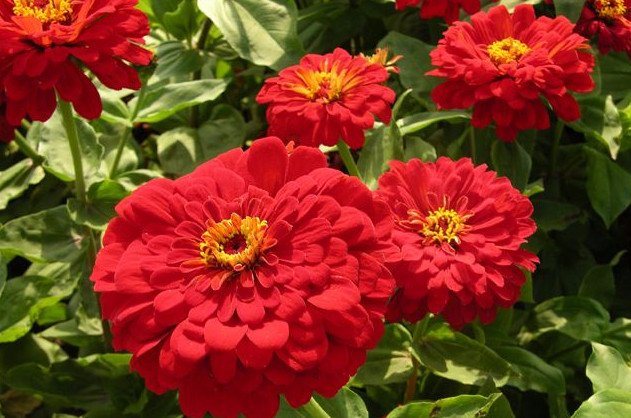

In the garden, he will be very comfortable in wet areas, where it is warm and a lot of light. Surprisingly, this flower can withstand any heat and drought without losing its appeal.
Blue daisies
Yellow daisies - perennial flowers
Blue flowers, which resemble chamomiles, are representatives of the genera aster, cineraria, osteospermum.
Aster
A garden flower loved by many. Gardeners are attracted by its unpretentiousness, simple agricultural technology, and a rich palette of inflorescences. Currently, there are over 600 hybrids and varieties of these flowers. Another name for asters is callistephus. China is considered his homeland. In Europe, the flower appeared in the 18th century.
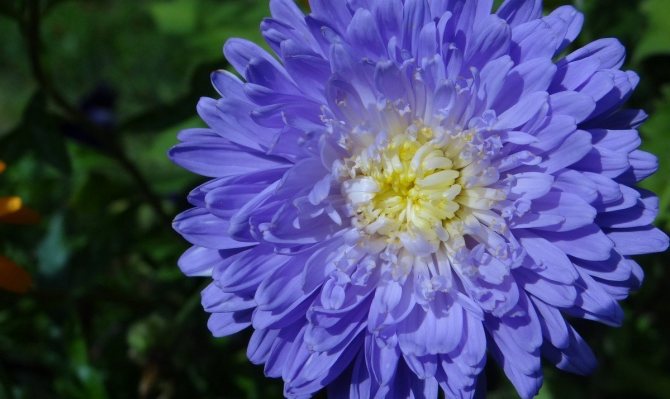

Aster
Aster features:
- stem height up to 50 cm;
- surface tap root system;
- inflorescence - basket.
Sowing seeds for seedlings - until June 10. From emergence to flowering, 80-130 days pass, these figures should be relied on when planting seedlings in open ground. Depending on when you want to see the first flowers, determine the time for planting the seedlings.
According to the lifespan, asters are one-year, two-year, perennial. The main types of aster inflorescences are 12. The simplest inflorescences of Zonenshine, Margarita, Edelweiss are most similar to chamomile. They have a middle and large petals along the edge.
Aster varieties similar to blue daisies:
- alpine blue aster;
- Baroness blue and white;
- Excellent Ruckley;
- aster heather Blue Parade.
Cineraria
The genus cineraria consists of 50 species. Translated from Latin, the name means "ashen". These flowers come from Madagascar. Cineraria is cultivated as an annual or biennial.
The height of bushes with strongly pubescent, pinnately dissected leaves is from 30 to 90 cm. Flowering from mid-June, until the onset of frost. The inflorescence is a chamomile-like basket with a dark or yellow center and bright envelope petals.
Cineraria
Seeds for seedlings are sown in early April, in open ground - in mid-May. Used as borders, mixboards, in flowerpots and flower beds.
Varieties and hybrids bloom with blue "daisies":
- Star Wars Blue Shades;
- Venice Blue Vis Ring;
- Venice Blue;
- Venice Delft Blue Vis Ring;
- Jester Blue Bicolor.
Osteospermum
A beautifully flowering herb. The homeland of the flower is South Africa, Somalia, the Arabian Peninsula, therefore it was named African chamomile. Osteospermum is sometimes referred to as Cape daisy or blue-eyed daisy.
The plant has the shape of a bush up to 1 meter tall. Blooms from early June until the onset of cold weather. The diameter of the inflorescences is 2.5-7.5 cm, they are open only when the sun is shining.
Varieties with blue petals:
- Sky and ice;
- Starry ice.
Cape chamomile is used in borders, mixed flower beds, mixboards, specimen plantings.
July paints
Summer is a flourishing period for many plants. In the middle of summer, in the hot month of July, such chamomile-like flowers bloom, such as:
- arctotis;
- venidium;
- cosmeya;
- erigeron;
- echinacea.
Arktotis, gabris, bear's ear, as soon as this bright representative of the Astrov family is not called. Blooming in July, the flower, represented by a large gamut of bright colors, pleases gardeners with its originality. Also, gabris outwardly has a similarity with multi-colored gerberas.
In our country, the bear ear is most often found in a perennial variety. The height of these flowers can reach 100 cm. Man has known the flower for more than 200 years, and during this time the admirers of its beauty have not diminished. And its green leaves really resemble the ears of a bear that lurked in the tall grass.
It resembles an alien flower, very similar to the terrestrial daisy, Venidium. The homeland of this colorful foreigner is hot Africa, and the lush Venidium is considered the most popular variety in the world. The flowers of the African guest in domestic gardens range from white to deep purple.
Venidium will be an excellent solution for those who rarely visit the country, but really want to decorate their site with bright and original plants. The flower easily tolerates a long absence of watering and can reach a height of 60 cm, while creating a beautiful colored carpet.
Tall graceful flowering plants with dill-like leaves are often found in the summer garden. These bright and delicate flowers, like daisies, only multi-colored, as they are called by the people, is not fully known, and their scientific name is kosmeya. Mexican aster, as the plant is also called, loves sunny open areas and, under favorable conditions, grows up to 80 cm.
Mexican aster pleases gardeners with its colors and sophistication until September. Despite all its tenderness, quite often kosmeya is found quietly growing along a dusty road or near a landfill.
The multi-colored erigeron or small petal, which outwardly resembles both a chamomile and a daisy, is also deeply rooted in the garden plots of fellow citizens of our country. A bright flower with airy inflorescences came to Europe from the American continent.
Depending on the selected variety, the height of the bush varies from 15 to 65 cm, and the color of the petals can be from pale white to lilac and burgundy-pink. If a small petal flower is cut as soon as it fully opens, it will stand for a long time in a bouquet in a vase of water.
Echinacea is a useful and beautiful flower often found in flower beds. From a distance it can be confused with pharmaceutical chamomile, since the petals of the inflorescence are lowered down and a tubercle of a dull yellow center stands out sharply upward. However, upon closer inspection, this guest of the gardens can still be distinguished from the snow-white queen of the fields.
Echinacea arrived in our country from America and took root well in the European climate. The plant is tall and can grow up to 150 cm. Echinacea petals are often colored white, yellow, orange and pink.
Chionodoxa: planting and care in the open field
White flowers that look like daisies
Flowers are like roses, but not roses - as they are called
There are a great many genera and species of Compositae, similar to chamomile in shape. Below we will consider a genus that is similar in shape and color.
Anacyclus
It is also called Spanish chamomile or saliva. Homeland - the Mediterranean coast in Europe, Asia, Africa. There are 6 varieties in the culture. Used in alpine slides and flower beds. There are annual and perennial varieties. The flower loves the sun, well-drained soil.
Varieties with white petals:
- anacyclus Garden gnome;
- the anacyclus is compressed;
- anacyclus medicinal;
- anacyclus clavate;
- anacyclus Ofitsinarum.
Anacyclus
"Daisies" blooming in summer
In this collection - 7 garden flowers, similar to chamomile, which bloom in summer - from June to August.
Anacyclus (anacillus)
It is not surprising to mistake Anacyclus for a chamomile - it really looks surprisingly like this flower. In nature, there are more than a dozen species of this charming plant.
Analyzes are both perennial and annual. Of the annuals in flower beds, the clavate anacyclus and the radiant anacyclus are most often grown. Of the perennials, the most common is anacyclus depressum.
Blooms from late spring to mid-summer: from May to July.
Gelikhrizum daisy-flowered
Of course, daisy-flowered gelichrizum is difficult to confuse with chamomile, but their inflorescences really have something in common.
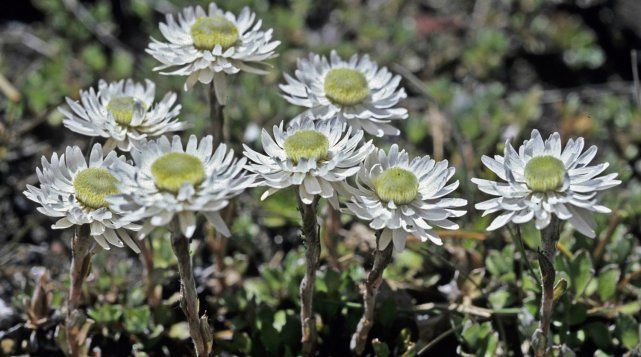

There are several common perennial species of immortelle, but in gardens they are usually grown as annuals and biennials.
The most popular in flower gardens of the middle zone are helichrizums - bracts (popularly known as immortelle), awl-leaved, helmet-shaped. More exotic ones are coral-shaped helichrizum, Milfordova's helichrizum, selago's helichrizum, etc. - at first, you can even take it for stonecrops.
Daisy-flowered gelichrizum blooms in June-August.
Doronicum (goat)
This yellow "chamomile" is ideal for rock gardens and rockeries, because its homeland is mountains. Doronicum is a perennial plant. Height varies depending on the species. The smallest are Altai doronicum and Kluz's doronicum, the height of their bushes starts from 10 cm.And the stately doronicum of Kolyumna, for example, can grow up to 80 cm.
Blooms from May to June or from July to August, depending on the species.
If you come across flowers that look like large daisies, this is probably a daisy. Their inflorescences are not easy to distinguish from each other. In addition, the second name of one of the most common species of this plant - common daisy - is meadow chamomile.
In general, there are about two dozen species of daisy known. Another popular species is the largest daisy. In flower beds, a huge number of varietal meadows of this species are grown. There are varieties with double and simple inflorescences, small or very large.
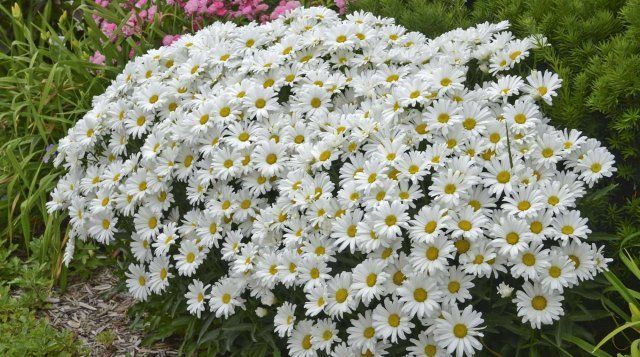

Most nivyaniks are grown as perennials.
This plant blooms in the first half of summer.
Calendula (marigold)
Calendula, or marigolds, is one of the most popular plants of the Astrov family, especially medicinal marigolds, a frequent visitor to flower gardens in the middle strip.
Calendula is a charming flower ideal for both flower gardens and ornamental gardens. It reproduces well by self-seeding, and in a few years will turn the corner of the site allotted to it into a flaming yellow-orange sea.
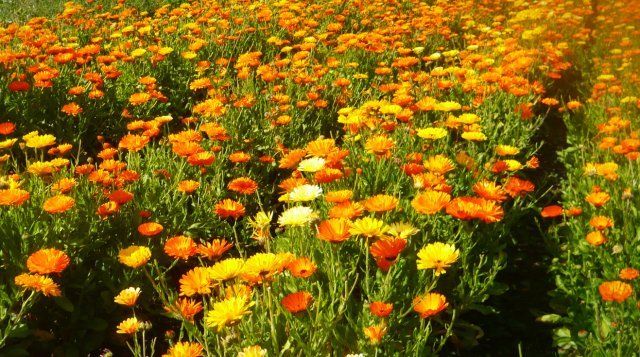

There are both low-growing varieties of the Patio group (up to 20-30 cm) and numerous tall varieties (Goldkugel - up to 65 cm, Canarienfogel - up to 60 cm, Yuvel - up to 50 cm, etc.).
Daisy
The daisy can be considered the cousin of chamomile - these two plants are so similar. Of course, when it comes to varieties with white flowers. But the daisy boasts a variety of colors: everyone knows the plants of this species with petals of a fuchsia shade, bright pink, coral in color.
Daisy blooms in late spring - early summer.
Feverfew is really very easy to confuse with chamomile. Many of its species and varieties have saucer-shaped inflorescences with white petals and a yellow core.
Most often it is a perennial plant, but sometimes it grows as an annual.
One of the most common types of feverfew is pink feverfew. A large number of pyrethrum varieties with different petal colors have been bred in the culture: James Kelvey (coral red), Brenda (deep pink), Bressineham Red (crimson), etc.
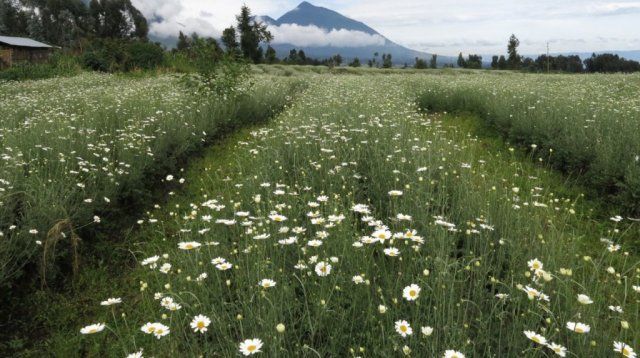

Other species (for example, pyrethrum scutellum, pyrethrum maiden) have white inflorescences.
This plant blooms in the first half of summer - in June - early July.
Orange daisies
Gerberas - what are these flowers, planting and care in the garden
Flowers with orange daisies, similar to suns, will decorate any flower bed and bouquet.
Doronicum (goat)
This genus includes up to 70 species. Doronicum is a mountain dweller. In the mountainous regions of Eurasia, it is found at an altitude of 3.5 km. In culture, the goat is known since the 16th century. The herbaceous perennial plant forms shrubs covered with bright flowers with yellow petals and a center.
The landing recipe is simple: they are sown for seedlings in early April, transferred to open ground in early June. Light-loving plant, tolerates slight shading. Usually there are two waves of flowering per season: at the beginning of summer and in the second half of it.
Popular species and varieties:
- doronicum Austrian;
- doronicum Altai;
- doronicum eastern variety Gold Dwarf;
- Spring Beauty variety;
- grade Little Leo.
- Excelsium cultivar
Used in alpine slides and as a free-standing plant.
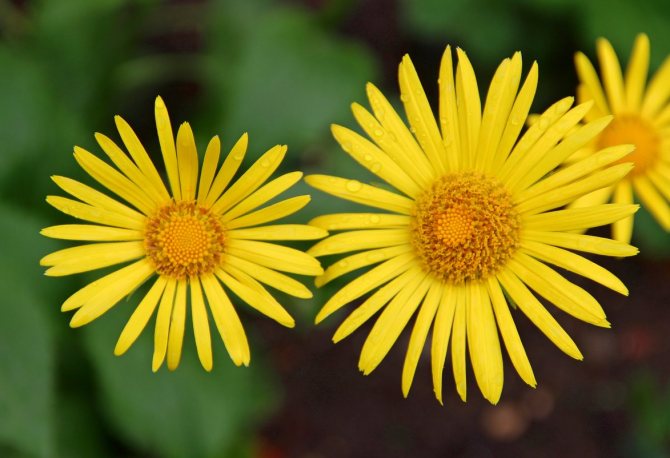

Doronicum
Exotic "relatives"
African chamomile or osteospermum is a rare flower in our country. Another well-known name is Cape daisy. Petals are not only white, but also blue, purple, lilac, red, yellow, orange. The dimensions of the basket are 3–8 cm. Interesting hybrids with unusual petal shapes, for example, resembling a spoon (spoon-like osteospermum), have been bred. Most similar to chamomile:
Read also: Growing dahlias in the garden: planting and caring for annual and perennial dahlias
16 excellent varieties of plums for the Moscow region
- Barberiae;
- Eklona;
- osteospermum is noticeable.
The bushes bloom and branch profusely. The plant does not lose its attractiveness even in rainy weather. To make friends with African chamomile, it is enough to prepare a sunny area with well-drained, not too fertile soil. The plant is thermophilic, at -10 ° C in the open field will die. For the winter they are transplanted and kept in cool rooms (+ 5 ... + 10 ° C).
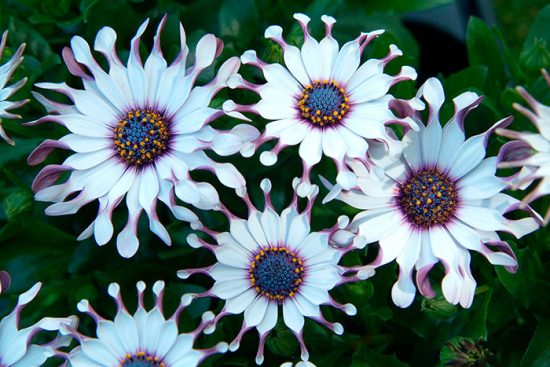

Gazania (gatsania) is another African "guest". A low-growing plant (30 cm) with red, orange, pink or yellow petals. The leaves are textured, dark green or with a grayish bloom. Grown as an annual and perennial.With proper agricultural technology and in favorable conditions of gating, it blooms all summer. The plant practically does not get sick, it can be affected by insects: ticks and aphids. For the winter, the bushes are dug up and kept in a well-lit, cool place. Watering is rare.
Homeland of Ursinia South Africa. Of the cultivated species, not all are suitable for the climate of the Middle zone, the dill ursinia is most adapted to it. The plant is not left for wintering, it is grown as an annual. Popular varieties:
For the abundant flowering of ursinia, 5 hours of sunshine is needed.
Pink daisies
Pink daisies are delicate and attractive. Let's consider some of the varieties.
Pyrethrum
The homeland of pyrethrum species is Europe, Asia and North America. Many representatives have antipyretic and anti-inflammatory properties. Most of the species are perennials. Height of stems up to 1 meter, powerful root system. The diameter of the baskets of pyrethrum can reach 60 cm.The peak flowering of these colored daisies occurs in May-June.
Pyrethrum seeds are sown on seedlings in early March, planting on the site is carried out in early June. These flowers are used in group plantings, as tapeworms, for cutting.
Varieties with pink petals:
- pyrethrum red or Caucasian chamomile;
- pyrethrum pink or persian chamomile.
Pyrethrum
Low-growing "daisies"
Flowers from this collection are grown in borders, mixborders, at the foot of rock gardens. They are also suitable for growing in pots and decorative arrangements.
| Anacyclus (anacillus) | |
| The height of this plant does not exceed 5-10 cm. Anacyclus has creeping shoots that are arranged in a circle and form curtains. Flowering falls in May-June. Inflorescences are white with a yellow center or completely yellow. In the perennial anacyclus depressum, the extreme ligulate flowers are dark pink, like all buds. During the rain and at night, the flowers close. The flower requires a sunny area with well-drained light soil. | |
| Arctotis short-stemmed, stemless, hybrid | |
| In culture, various varieties of hybrid, stemless, short-stemmed arctotis are often grown. Their height usually does not exceed 15-20 cm. The colors are very diverse: from white to deep purple. The plant loves well-lit areas. Grow best on rocky soil. They are distinguished by drought and cold resistance. Bloom from July to September. | |
| Gatsania | |
| Gatsania (gazania) is a perennial southern plant that is usually grown in the middle lane as an annual. Depending on the species, it blooms from early summer to mid-autumn, until the onset of frost. The height of gatsania usually does not exceed 30 cm. It is suitable for growing in containers - in this case it can be grown as a perennial. Looks decorative thanks to the variety of color options. Many varieties with variegated petals can be found on sale. Easily propagated by seeds and cuttings. Drought-resistant, withstands frosts down to -7 ° C. | |
| Gelikhrizum daisy-flowered | |
| Gelikhrizum of this species is a low-growing perennial that forms a curtain up to 50 cm in diameter and up to 8 cm in height. White inflorescences, similar to chamomile, rise above the rug of gray leaves on low peduncles. Daisy-flowered gelichrisum blooms all summer, from June to August. This plant grows very quickly, does not have any special requirements for care. | |
| Doronicum Clusa | |
| Doronicum Kluza grows up to 10-30 cm in height. Inflorescences with a diameter of 3-6 cm, similar to chamomile, bright yellow in color. Blooms in July-August. Winter-hardy, loves open sunny places. Prefers loose, well-drained, fertile soil. | |
| Calendula officinalis | |
| Calendula officinalis can grow up to 70 cm, depending on the variety, but it cannot be called a tall "giant". The average "growth" of calendula is 20-50 cm. It reproduces by self-seeding.Unpretentious. Used to compose herbal preparations. Calendula repels many pests, so it is advised to plant it along the beds. | |
| Cosmeya double-feathered | |
| A herbaceous annual that forms sprawling bushes up to 50 cm high. The color scheme is varied: there are varieties with pink, purple, burgundy petals. The inflorescences are very large, sometimes exceeding 10 cm. It reproduces well by self-seeding. Can be grown in containers on balconies and patios. | |
| Coreopsis pink | |
| The height of pink coreopsis is up to 40 cm. The bushes are quite lush, spreading. Inflorescences are small - up to 2 cm in diameter. Depending on the variety, they are pale or bright pink. This perennial grows well in one place for several years. For planting, choose well-lit areas with loose, light fertile soil. Blooms from July to September. To increase frost resistance, after flowering, the aerial part of the plant is cut off. | |
| Perennial daisy | |
| The height of the daisy bushes does not exceed 30 cm. Unpretentious, but needs regular hydration. The optimal soil type is light loam, rich in humus. Brings partial shading. There are varieties with different colors of inflorescences: Beethoven (pink), Schneebal (white), Rob Roy (red), Etna (dark pink), etc. There are also varieties with an unusual shape of inflorescences: the Tasso and Rominett series (pom-pom inflorescences), the Habanera series (lancet inflorescences). | |
| Ursinia dwarf | |
| The height of dwarf ursinia is only 8-15 cm. Inflorescences are light orange. The center of the flower is darker, ocher. Flowering lasts from July to September. Well-lit, drained areas are selected for ursinia. Can be grown in containers. | |
| Chrysanthemum arctic | |
| One of the shortest species of chrysanthemums - up to only 30 cm in height. Very late bloom, falling in autumn (late September to November). Inflorescences similar to chamomile, can be either white or a different shade. Growing rapidly. Forming curtains. Loves humus-rich soils and sunny areas. Frost resistant. | |
| Chrysanthemum korean | |
| Korean chrysanthemums are a group of hybrid chrysanthemums, the flowering time, "growth", color, shape of inflorescences and other features of which differ depending on the variety. The height of the Korean chrysanthemum bushes does not exceed 30-50 cm. As a rule, flowering occurs at the end of summer - autumn. These chrysanthemums are planted in well-lit, windproof areas. | |
Small daisies
There are a lot of plant species with small multi-colored daisies. The most common in flower beds are Bland's anemone, argirantemum, gelichrisum, mesembriantemum.
Anemone Blanda
Chamomile-like primrose from the buttercup family. Another name is tender anemone. In the Russian Federation, the wild anemone is listed in the Red Book.
Features of the plant:
- tuberous rhizome;
- bushes from 7 to 25 cm high;
- leaves are dark green, dissected;
- single chamomile flowers;
- petals of blue, lilac, white flowers;
- the diameter of the flowers is 5-10 cm.
Anemone is a perennial that blooms for 3-4 weeks in April-May. Used on flower beds, alpine slides, borders. It goes well with other primroses: daffodils, primroses, muscari will become excellent neighbors for anemones. The flower is unpretentious, feels good both in the sun and in partial shade.
Anemone
Argiranthemum
Another name is daisy chrysanthemum. A profusely flowering shrub, its homeland is the Canary Islands. Blooms from July to October with a large number of small daisies. The color of the petals is white, burgundy, blue, yellow.
Cultivated species of Argirantemum:
- shrub argiranthemum;
- argiranthemum adauctum;
- argiranthemum broussonetii;
- argiranthemum callichrysum.
Argirantemum is a finicky plant, it is difficult to create ideal conditions for it. The old parts of the shoots are lignified, the bush can reach a height of 80 cm.It can be perennial if carried indoors for the winter.
Argiranthemum
Gelikhrizum daisy-flowered
Gardeners call gelikhrizum immortelle or tsmin. His homeland is South Africa and the Australian continent. In the middle lane, these unpretentious plants bloom until the first frost. The peculiarity of gelichrizum is that in cut it can stand up to a year, retaining the bright color of the petals.
Appearance:
- ribbed stem up to 120 cm high;
- leaves are narrow, dark green, pubescent;
- basket diameter up to 7 cm;
- the petals are dry, bent inside the inflorescences.
Gardeners grow about 30 species of immortelle. Most Popular:
- bracts immortelle;
- coral gelikhrizum;
- cmin milf-like;
- daisy-flowered gelichrizum;
- sandy cmin;
- narrow-leaved immortelle;
- Helichrizum Selago.
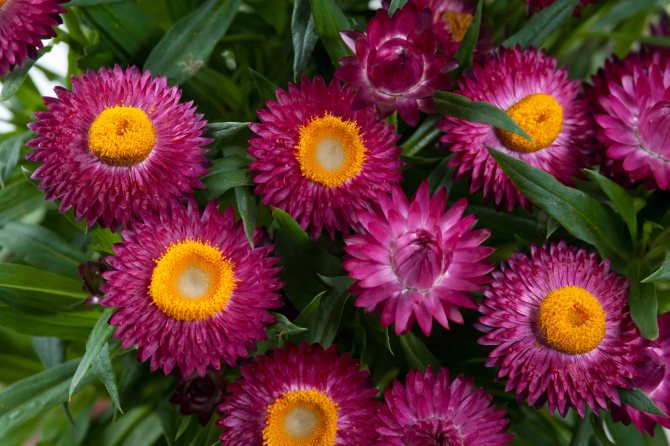

Gelichrizum
Immortelle seeds for growing seedlings are sown in late March. The seedlings are transferred to the flowerbed at the end of May. The first flowers appear in mid-July. In landscape design, gelichrizum is used for the background of mixboards, in rockeries together with lobelia, escholzia and stonecrops.
Mesembriantemum
One-year or two-year-old succulent from the Aziz family. Most often these are low, creeping or creeping plants no more than 15 cm high. Fleshy sessile leaves of a fusiform or rounded shape. The flowers of the mesembranteum are similar to colored daisies with white, pink, red petals.
Grown through seedlings, planted in open ground in late May and early June. The flower does not like waterlogging.
Types and varieties used by flower growers:
- crystal mesembriantemum: Sparkle variety;
- Harlequin variety;
- Limpopo variety;
In landscape design, it is most often used as a ground cover plant.
Mesembriantemum
List of indoor flowers
The elements of indoor floriculture allow you to continue the summer, to make the winter landscapes outside the window of your own house warm, beautiful. Flowers that resemble summer chamomile are considered especially pleasant and unexpected. Modern technologies for growing potted plants help to create home beds from any plant. The lack of light is compensated by special radiation sources. Watering, feeding, pest control is carried out according to the recommendations of specialists. Back in the 13th century, the first winter garden appeared in Europe. Now in any big city windows of greenhouses are shining, tropical palm trees are raging in theaters and offices.
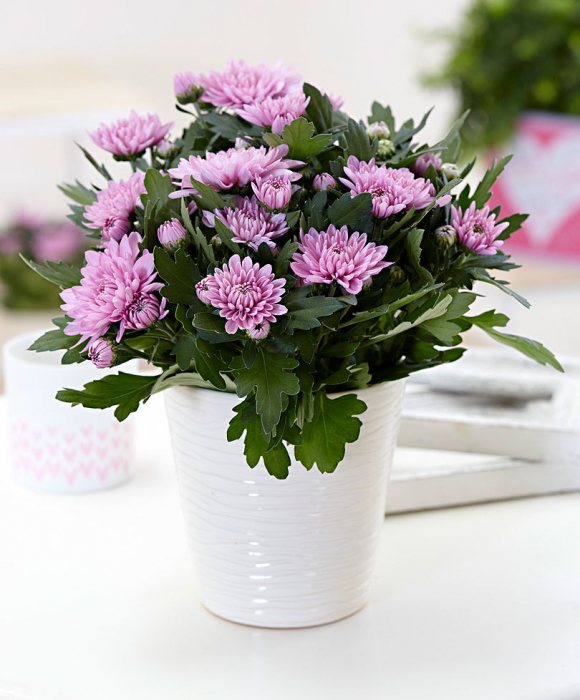

Photo: zadenplanten.nl
The range of indoor flowers for two centuries has been formed from a large number of proposals. The most popular chamomile-type indoor flowers are gerberas and chrysanthemums. There are many varieties of Korean chrysanthemum in different colors and flowering times. Dwarf species with double inflorescences look beautiful on windowsills, shelves. Tall species are used for growing in the open field for the purpose of decorating flower beds and subsequent cutting.
Gerbera jamesonii H. Bolus is considered the ancestor of indoor gerberas. The proud, fragile chamomile (gerbera) is brought from Holland in the fall. In the pots there is a flowering plant with double, simple flowers of orange, red, white, pink shades with a yellow chamomile center. The plant loves light, warmth. The trade offers also include species of small Gatsania daisies. Some varieties of a multi-colored bush have flowers with a gradient color. In pots, containers, they are taken out on balconies, verandas, in open ground.
Large daisies
Chamomiles with baskets up to 15 cm in diameter look spectacular both on a flower bed and in a bouquet. What are the big daisies called?
Gerbera
Herbaceous perennial plant. Often used in bouquets. Can be grown on site and at home. Gerbera native to tropical Asia, South Africa and Madagascar.Occasionally it is called the transvaal daisy.
Gerbera flower stalks are up to 60 cm high. The rosette of leaves is low, located near the ground. Leaves are smooth, leathery, dark green.
Gerbera blooms from August to November. The petals are painted in a variety of colors and shades: from white to maroon, collected in a double or triple row along the edge of the basket.
There are a lot of types and varieties of gerbera, most often you can find:
- Gerbera Jameson;
- green-leaved gerbera (ordinary);
- hybrid gerbera: Festival variety;
- grade Alkor;
- Jupiter variety;
- grade Mars.
Transvaal chamomile propagates by seeds, dividing a bush, cuttings. Used in curbs, mixed flower beds, as a tapeworm. Gerberas are also grown as house flowers.
Gerbera
External signs of daisies
White petals and a yellow center of the flower are signs that unite different plants. The genus of daisies - perennials from the Astrov family - includes more than 20 species of herbs that bloom in the first year of life. Its representatives are low, herbaceous plants with pinnately dissected leaves (each consists of a large number of thin lobes).
Read also: Ranunculus: planting and care
The diameter of the hemispherical or conical baskets of inflorescences, united into a common corymbose inflorescence, varies in different species from tiny daisies 2 cm in diameter to huge 20 cm. Baskets consist of two types of petals: bisexual tubular yellow in the middle and pistillate false-colored white ones at the edges.
African chamomile, or gatsania
The genus gatsania includes about 40 species of herbaceous plants. In Europe, the flower appeared in the 17th century and was called "midday gold", as it opened at noon.
Gatsania is an annual or perennial plant, about 30 cm high. Dark green root leaves form a ground rosette. The diameter of the inflorescences can reach 9 cm. The petals are painted in a variety of colors and their combinations. Gatsaniya is grown through seedlings. Seeds are sown in the second half of March, and planted under the open sky in late May and early June. Gatsania blooms from June to October. Each flower lives up to 20 days.
Types and varieties:
- long rifle gating;
- gating harsh, or shiny;
- gatsaniya Pottsi;
- peacock gatsiya.
Landscaft designers use gating for mixboards and flower beds.
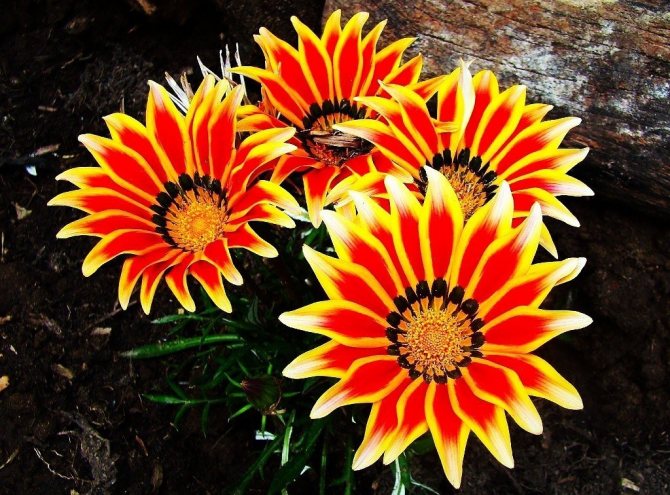

Gatsania
Chamomile, green and golden
The most famous type of chamomile is the pharmacy, which in the scientific community is called Matricaria chamomilla. Her leaves are very small, simple, sessile with a pinnately dissected type of venation. Knowing these features helps distinguish the plant from species with similar inflorescences.
Real chamomile leaves look like dill leaves.
The size of chamomile inflorescences is about 2.5 cm in diameter. There are two types of flowers in its basket. On a convex receptacle, which acquires an almost conical shape as the bush ages, there are small yellow flowers with a simple perianth. Along the outer contour of the receptacle, white ligulate flowers grow, the number of which is usually 12 or 18 pieces.
At the time of flowering, the chamomile bush looks like this:
Inflorescences similar in color combination are odorless chamomile, some types of umbilicals (including dog chamomile and field chamomile), Roman chamomile, some pyrethrum and tansy.
Chamomile belongs to the genus Matricaria, which includes only 25 plants. They are considered true daisies, while other plants are called so only in common parlance, having different names.
Most Matricāria species are characterized by the same structure of inflorescences and a combination of only yellow and white flowers. The exception is green chamomile, which is also called fragrant or tongueless, and in the scientific community - Matricaria discoidea, and golden chamomile - Matricaria aurea.
On the inflorescences of green, only tubular flowers are present, which, as the name suggests, are green. She has no marginal "petals" at all. The plant is also distinguished by a strong specific smell and a small height of the bushes. As a rule, they grow up to only 20-30 cm.As you can see from the photo, they look very different from the chamomile bushes:
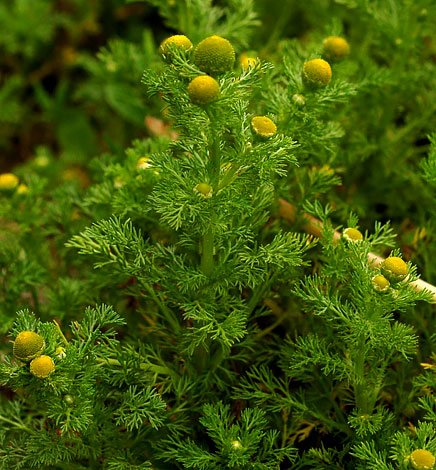

Quite similar to this species, golden chamomile. It differs from green mainly only in the color of the inflorescences, which in this plant is yellow. The diameter of the inflorescences is very small - no more than 0.8 cm, and the height of the bushes is about 25 cm.An important feature of the species is the fact that flower baskets can grow singly, and not in corymbose inflorescences, like most other representatives of the genus Matricaria.
Nivyanik or popovnik
It is the daisy that is most often called chamomile, but this is a separate genus of the Compositae family. Eurasian tree or popovnik is a herbaceous perennial plant up to 70 cm high. The stem is straight, almost does not branch. Basal rosette of simple leaves.
The plant is unpretentious, caring for it is not difficult and is available even to a novice florist.
Breeders have created many interesting varieties of the daisy:
- Maxima Kenig;
- May Queen;
- Alaska;
- Bethoven
- Nivyanik Luna;
- Winner;
- Bridal veil;
- Fiona Coghill.
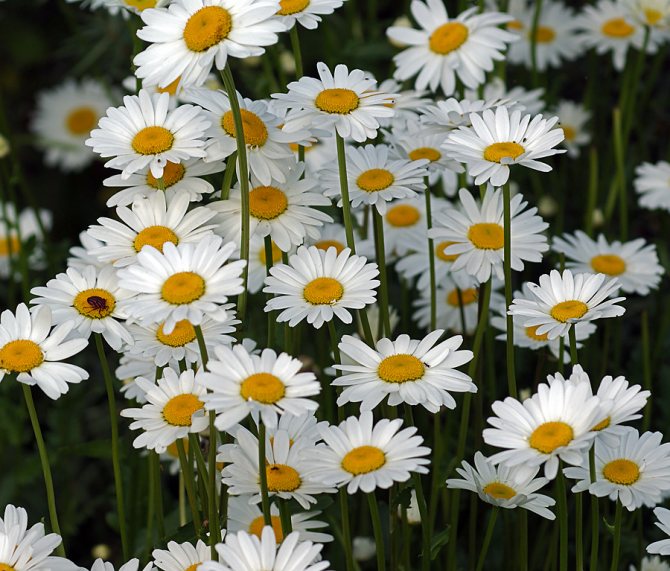

Nivyanik
Differences between daisy and chamomile
Why are daisies and chamomile often confused? Let's compare these plants.
| Sign | Nivyanik | Chamomile |
| Basket size | up to 12 cm | up to 6 cm |
| Sheet | Dense, rigid, solid, with a scalloped edge. | Cirro-dissected |
| Stem | Single, carries one basket | Branched, bears many inflorescences |
| Smell | Light "chamomile" aroma | Without smell |
Nivyanik is used in solitary, mixed plantings in flower beds, along the walls.
White and colored "daisies"
Not all chrysanthemums can be confused with chamomile. Perhaps the most similar varieties are:
Flower bed design. TOP 10 simple and effective techniques
- arctic white;
- autumn (late);
- Indian (golden yellow petals);
- Bacardi (classic "chamomile" color combination).
Small multi-colored corollas are cineraria. At the base, the petals can be white, and the edges are colored. The height of the stems is from 25 to 70 cm. There are also monochromatic cineraria, for example, snow-white hybrid varieties with a red center.
Anemone Blanda and hybrid Coronal - resemble chamomile. Representatives of the bulbous family love partial shade and well-drained fertile soil. Anemone petals are delicate, sensitive to winds and bad weather. There are about 160 species of anemone in total.
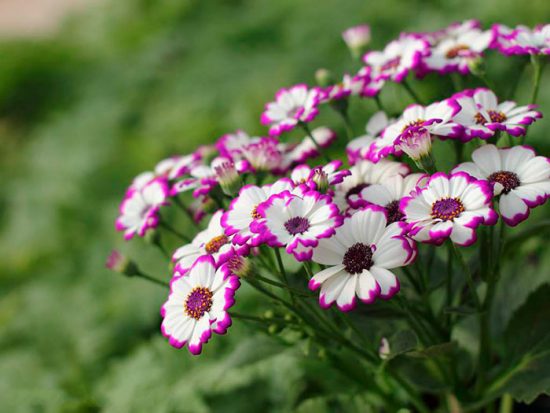

There are some similarities with chamomile in the immortelle, especially in gelichrizum. Ground cover perennial about half a meter high with snow-white petals and a yellow center. In August, when the flowers dry up, the immortelle does not lose its decorative effect.
Multicolored daisies with a yellow center - why not daisies? Unpretentious annuals are bred themselves from seeds. Two-year-old daisy to preserve the variety, propagated by cuttings.
It is difficult to list all the plants that look like chamomile. Different in color, size and even growing conditions - these "basket" inflorescences are united by a common "chamomile" charm.
Echinacea or large chamomile
Echinacea is an unpretentious and bright flower, an excellent honey plant and decoration of any flower bed. It blooms from mid-July to mid-September. Echinacea plant is unpretentious, prefers sunny places. Propagated by seedlings or buy an adult plant in garden centers.
American chamomile
Echinacea is also called American chamomile, as it comes from North America. The genus Echinacea unites 9 species, most often flower growers prefer Echinacea strange and Echinacea purple, as the most decorative.
Varieties:
- Cranberry Cupcake;
- The King;
- White Swan;
- Indiaca;
- Magnus.
Butterflies are very fond of visiting Echinacea, in addition, it is used in folk medicine as an immunomodulator.
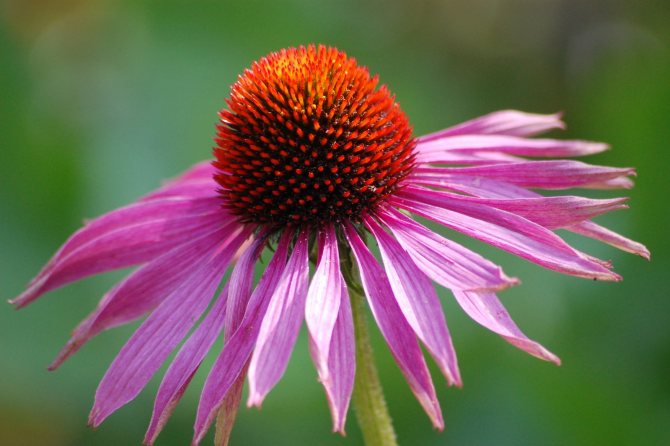

Echinacea
What flowers similar to chamomile are medicinal
Chamomile inflorescences and leaves have pronounced medicinal properties and are used to treat inflammatory processes, diseases of the stomach and intestines, skin, and the genitourinary system. The plant flower tea helps to cope with sleep disorders, depression and stress.In addition, the flower infusion strengthens the immune system.
Reference! Plants such as daisy and echinacea have similar properties.
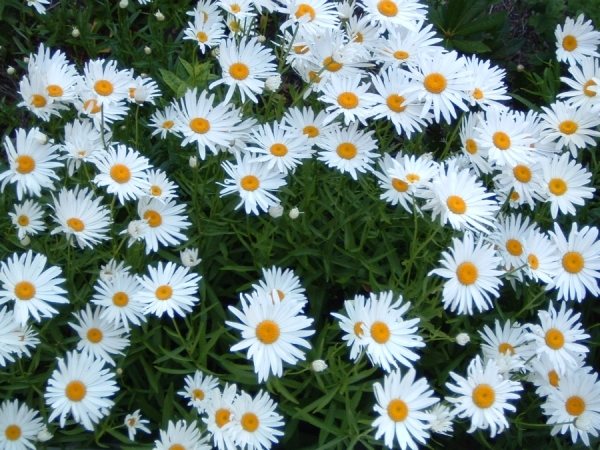

It is useful to drink decoctions and infusions of flowers and leaves of the daisy for colds, to relieve pain and inflammation in the digestive tract, as a diuretic for inflammatory processes in the kidneys and urinary tract. Nivyanik fights insomnia, relieves fatigue and calms the nervous system.
The main characteristic of therapeutic echinacea is to strengthen the body's defenses. The plant protects the cardiovascular system, cleans blood vessels from plaque and increases their elasticity. Echinacea tea normalizes sleep and treats depression, protects against premature aging and improves metabolic processes.
Terry calendula
The homeland of calendula is the Mediterranean. It began to be cultivated by humans for its medicinal properties. Calendula heals wounds, improves digestion, and has antiseptic properties.
In warm climates, calendula is a perennial. We have an annual plant in the middle lane. It is a herbaceous plant with a maximum height of 80 cm. The leaves are strongly pubescent. Branches profusely, with several inflorescences-baskets on each stem. Coloring of petals from light yellow to brick-orange.
The plant is unpretentious, resistant to cold, easy to care for. Propagated by self-sowing, keeping varietal characteristics. The difference between terry calendula is a large number of reed flowers in the inflorescence. This makes it look like an aster.
There are many varieties of calendula or marigold, they differ in the height of the bush, the degree of doubleness of the flowers. The most interesting varieties:
- Candyman Orange;
- Goddess of the sun;
- Sun of Egypt;
- The heel is yellow;
- Red Devil;
- Indian prince.
A monochrome flower garden, similar to a cake, made up of different varieties of calendula, will delight with flowering until the frost.
Calendula
"Daisies" blooming until autumn
In this selection, we have collected not only chamomile-like plants that bloom in autumn, but also those, most of which bloom in the second half of summer, but also captures September. In a word, those that are in bloom right now.
Like all chamomile-like flowers, arctotis has saucer-shaped inflorescences. Petals can be either white or orange, ocher, purple, purple, yellow, pink. Externally, the inflorescences are also similar to a gerbera.
The height varies depending on the type and variety of plants, but usually does not exceed 15-20 cm. The exception is steacholist arctotis, which can reach 1 m in height.
The most common perennial species - arctotis hybrid, arctotis short-stemmed, arctotis stemless, arctotis stekhasolistny - are grown as annuals or biennials.
Arctotis bloom from July to September.
Gatsania
Gatsania (or gazania) is an African beauty that can be mistaken for chamomile from afar. But upon closer inspection, it is easy to notice that, unlike the shy chamomile, it boasts a huge variety of color options for the petals: here they are yellow-orange, and pink, and purple. Moreover, many of the flowers have a bright colored ring at the base or striped petals.
The size of the inflorescences can exceed 10 cm in diameter. Some species and varieties of gatsanias may resemble gerberas.
Flowering lasts all summer until autumn. Gatsania hybrid and long-shot gatsania bloom in the second half of summer and bloom until mid-autumn.
Gerbera
Breeders know about 7 dozen species of gerberas. Depending on the variety, the height of the peduncles can be from 25 to 60 cm. The color of the inflorescences can also be varied - white, orange, red, yellow, pink, crimson.
Gerberas love the sun and warmth, so in the middle lane they are grown in containers on balconies and patios, in pots at home or in greenhouses.
Venidium
Venidium is an infrequent guest in our gardens.It is usually grown in containers and pots.
The most common type of this flower is the lush venidium. He has rather large flowers - their diameter reaches 10 cm.The plant itself grows up to 70 cm.
The flowers have a dark center and a bright orange-purple ring around it.
Venidium blooms from late July until frost.
Kosmeya
Kosmeya (or cosmos) is a popular plant in midland gardens. This is a rather "independent" herbaceous annual, which does not require special care and reproduces without problems by self-seeding.
The most popular of this flower is double-pinnate cosmeya. Her flowers are most often simple, but there are also double varieties. The colors of the petals are varied: purple, lilac, pink.
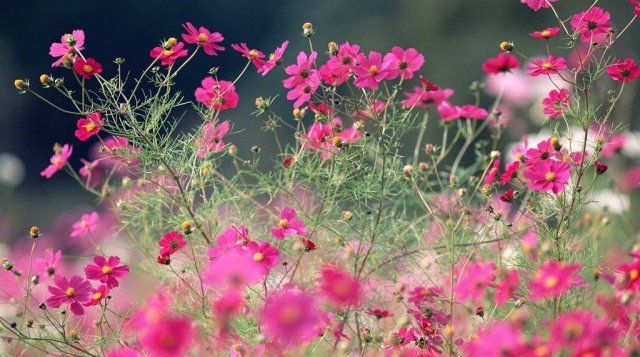

The cosmos has sulfur-yellow inflorescences in ocher-orange tones. From afar, it can be mistaken for marigolds.
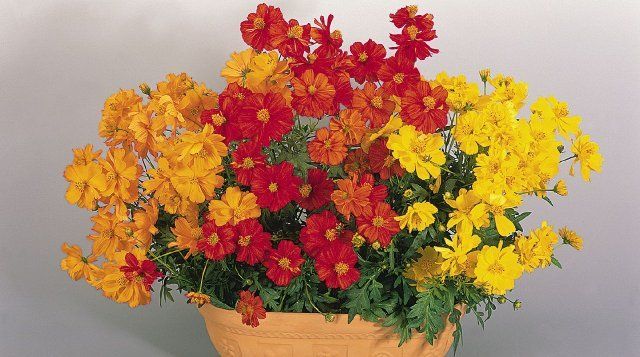

The rarest species of this plant is chocolate kosmeya (also called black or blood-red kosmeya). Her flowers are a really deep brownish-burgundy hue, and, most surprisingly, exude a subtle chocolate aroma!
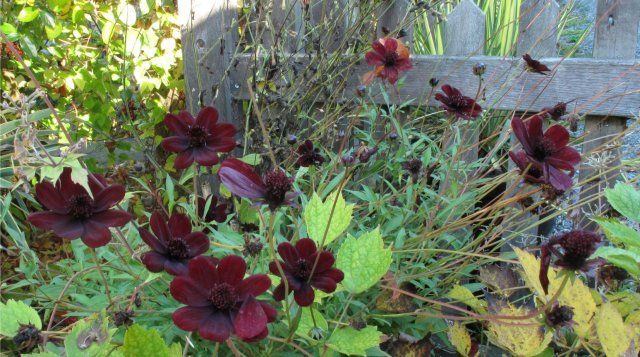

Unfortunately, in cold climates it grows only in containers and requires wintering indoors.
Coreopsis
Coreopsis look like brightly colored daisies. Depending on the type and variety, the inflorescences have yellow, orange, pink, purple petals.
Height varies greatly from species to species. For example, bushes of auricular coreopsis grow up to 30 cm, in large-flowered coreopsis - up to 100 cm.Flowering occurs in the second half of summer and early autumn: from July to September.
Coreopsis prefers open, sunny areas with good drainage. This is especially important in winter - during a thaw, the flower can rot if it is planted in a heated place.
Osteospermum is also known as the Cape daisy, and in the West it is also known as the African daisy. Its obvious advantage is lush flowering until late autumn, because cold temperatures stimulate the opening of buds.
The ideal location for osteosperum is in areas well warmed by the sun. However, it cannot be called a sissy - it does not lose its decorative effect even on gloomy, rainy autumn days.
Sunflower
Of course, to confuse table sunflower with chamomile, you need to try hard. But among the decorative sunflowers there are enough varieties that are very similar to this flower.
For example, the small-headed sunflower of the Lemon Queen variety looks like a cross between chamomile and rudbeckia.
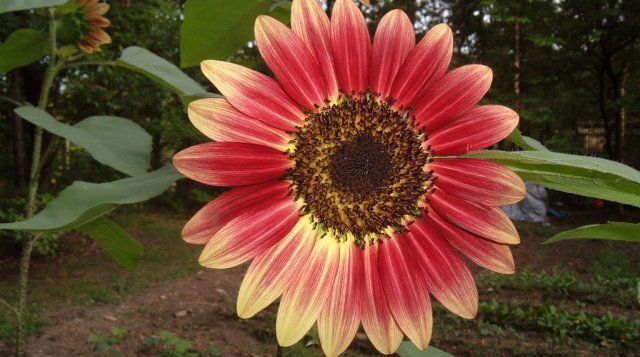

In warm climates, sunflowers bloom until frost.
Jerusalem artichoke
Like sunflower, Jerusalem artichoke, or earthen pear, plants are both decorative and table. Only, unlike the first, it has good tops and roots.
Jerusalem artichoke blooms with charming lemon-yellow inflorescences and at the same time is able to winter in the garden even without shelter!
Flowering occurs in August-September.
Ursinia
One-year ursinia is most often grown in culture. This plant is native to Africa, so it is used to good lighting.
In the middle lane, dill ursinia is widespread, which can be identified by its characteristic pinnately dissected leaf shape, and ursinia is beautiful.
The plant grows up to 30-50 cm in height. The exception is dwarf ursinia - its "height" does not exceed 15 cm.
Ursinia continues to bloom from June to early September.
Chrysanthemum
Chrysanthemum is a traditional plant in the autumn garden. Korean chrysanthemums, which are most often used in bouquets, are difficult to confuse with daisies - they are easily recognizable. But less popular species, for example, Indian, arctic or autumn chrysanthemum, are surprisingly reminiscent of this modest flower.
By the way, the bushes of autumn chrysanthemum can reach 160 cm in height.
Chrysanthemum bloom lasts from late summer until late autumn.
Echinacea
There are 10 known types of Echinacea, but Echinacea purpurea is the most common.Despite the telling name, the color of the inflorescences can be not only purple, but also red, yellow, cream.
It is quite easy to recognize Echinacea by its characteristic convex center and drooping petals.
Echinacea can reach a height of 1.4 m! It can be propagated both vegetatively and by seeds.
This plant blooms from July to September.
Other flowers
Gardeners know many flowers that look like chamomile, but not with white, but very bright petals.
Arctotis
The aster family is endemic to the Cape region in Africa. Arctotis is a herbaceous plant or shrub. It is characterized by dense silvery pubescence on the leaves. Inflorescences-baskets reach 8 cm in diameter. Painted in white, purple, pink.
Arctotis
Coreopsis
Yellow or golden brown chamomile, the name of which is translated from Greek as "a kind of bug." Coreopsis blooms in late summer and early autumn. Herbaceous plant or shrub, 20 to 60 cm high, depending on the variety.
Views:
- large-flowered coreopsis;
- lanceolate coreopsis;
- whorled coreopsis.
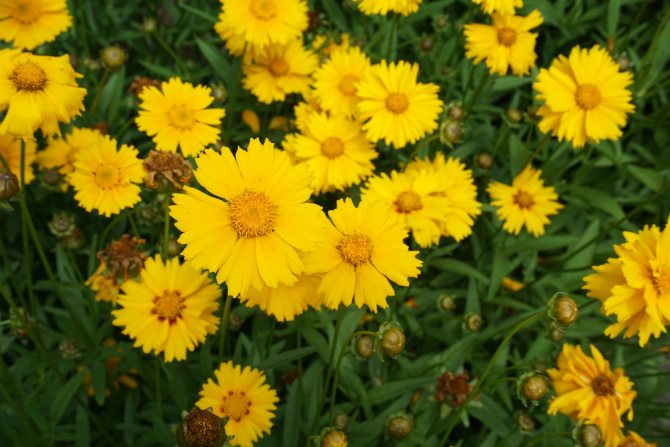

Coreopsis
Perennial sunflower
In Europe, sunflower appeared in the 17th century. For three centuries of breeding, the original nondescript plant has turned into an oilseed crop and a garden decoration.
The ten-petalled sunflower variety is the most decorative. The golden balls of inflorescences look more like a chrysanthemum than a sunflower. This is a tall perennial, reaching 2 meters in height. It is unpretentious in care, responds gratefully to feeding.
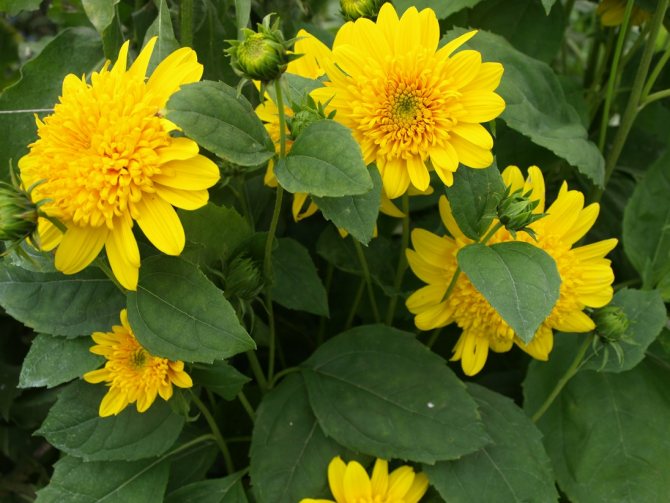

Sunflower
Kosmeya
The pink and white cosmea flowers with corrugated petals are familiar to many. Undemanding to care, it will decorate any flower bed and border. Light green, light, pinnate leaves of this plant create a "cloud" on the surface of which the stars of inflorescences are scattered. In some varieties of double-feathery cosme, the diameter of the inflorescences can be up to 10 cm in diameter.
Varieties:
- Dazzler;
- Purity;
- Radiance;
- Bilbo.
Kosmeya
Among all the many plants that look like chamomile, each grower will choose which one to plant on his site. The choice of a type and variety, in addition to preferences, depends on the idea of the master designer, his goals and objectives.
What do these flowers look like?
Pharmacy chamomile
Chamomile and most plants similar to them belong to the Aster family. Its representatives are easy to identify by:
- herbaceous stem;
- elongated petals;
- a basket framed with petals;
- weak aroma.
Relatives of chamomile are sunflower, thistle and dandelion. They also belong to the Aster family and have similar characteristics.
The most common type of chamomile is pharmacy... In flower beds, most often there is a large or decorative one. Asters, some varieties of chrysanthemums and gatsanias also have large inflorescences.
Multicolored daisies
The first sign by which you can distinguish them is the color of the petals. In chamomile, pharmaceutical or decorative, they are white. There are similar flowers with different shades of petals..
Blue
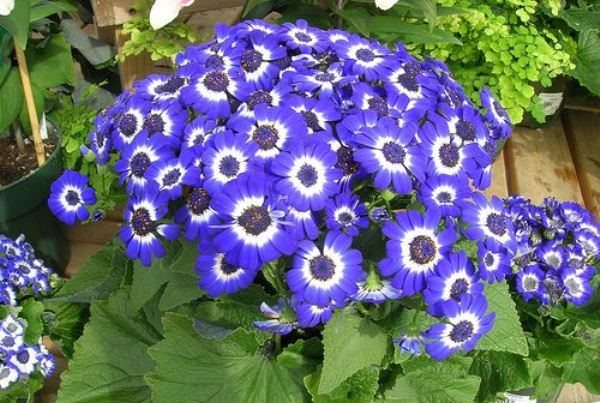

Cineraria Blue Asters
Blue color indicates that Asters or Cineraria have grown... In the latter, the petals are sometimes colored half white, which creates a pleasant decorative effect.
Colored
Anemone Blenda
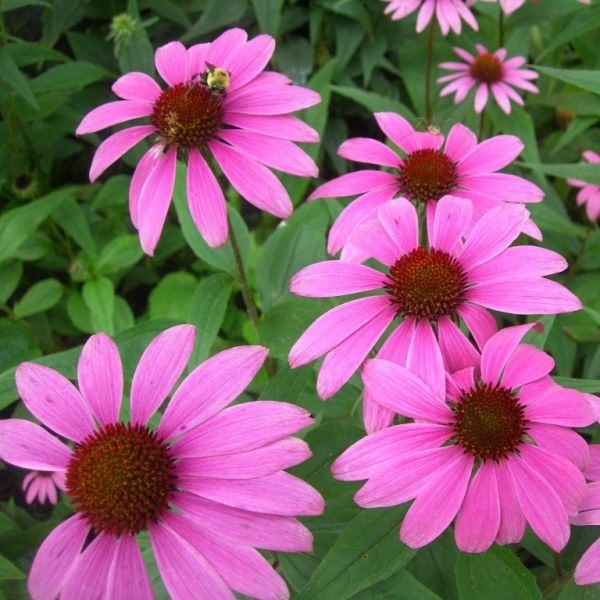

Echinacea
Colored daisies, which have petals in different colors and shades, called Anemone Blenda or Anemone Crown... Echinacea varieties have a similar color.
Yellow
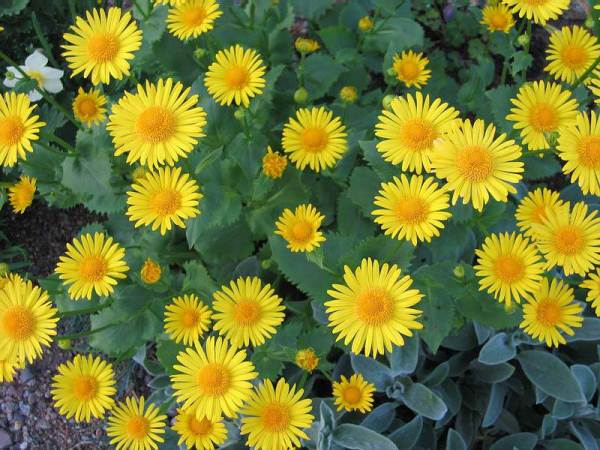

Doronicum
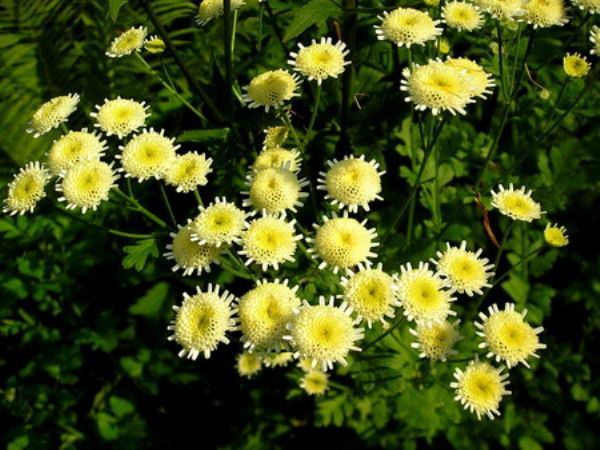

Pyrethrum
Doronicum (goat) is most often confused with yellow... You can also find Pyrethrum with lemon-colored petals, this variety is very similar to Chrysanthemum due to the double petals and the shape of a small shrub.
Purple and lilac
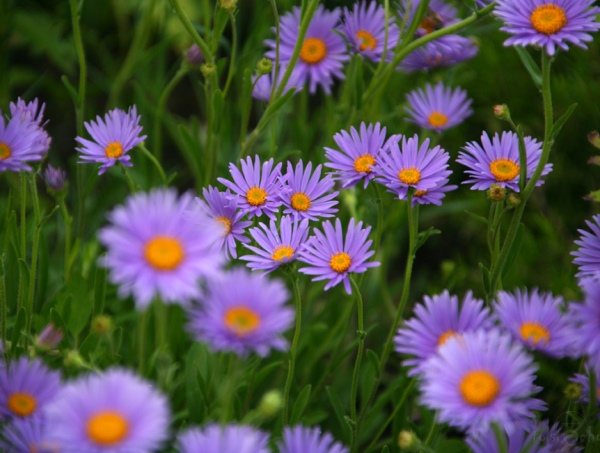

Lilac chamomile
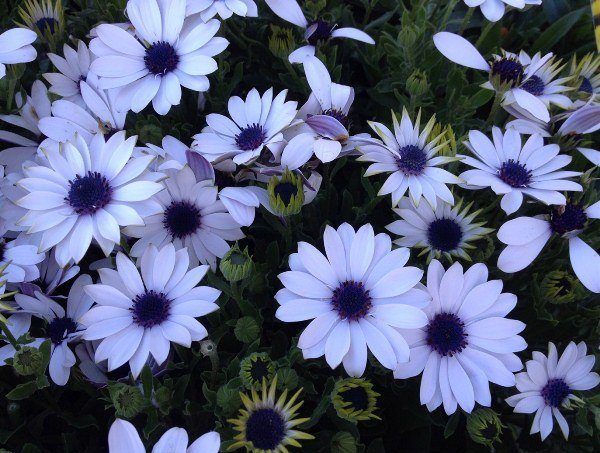

Osteospermum
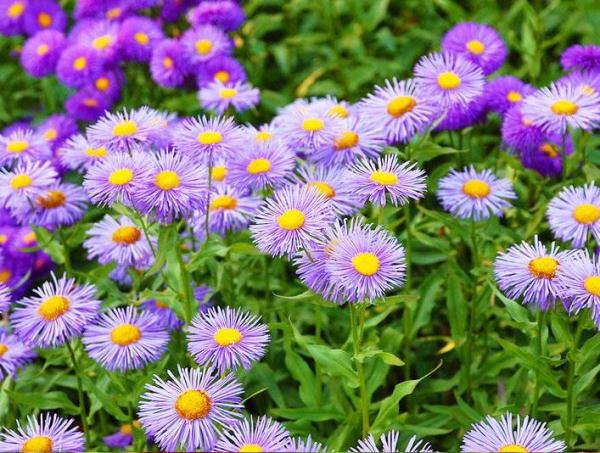

Lilac asters
Asters, Osteospermum with purple petals look very beautiful in borders and bouquets... This also includes lilac daisies, the brightness and type of shades varies depending on the variety of a particular type of plant.
Plants with multi-colored inflorescences
In some plants, inflorescences are multi-colored. Often, on one petal, 2-3, and sometimes even more, shades are combined at once. Thanks to this, the plants look very impressive and exotic.
Multi-colored daisies are called:
- Gaillardia spinous;
- Osteospermum;
- Gazania;
- Venidium;
- Arctotis;
- Ursinia umbilical and other similar flowers.
Spinous Gaillardia is a perennial shrub whose stems reach 90 cm in height. The diameter of the flower baskets is usually 7 to 12 cm. The tubular flowers located in the center are dark red or burgundy. The petals of this plant are three-toothed. They are colored yellow along the outer edge, and red or purple closer to the middle. In some varieties, they are arranged in several rows.
Gaillardia bushes look like this:
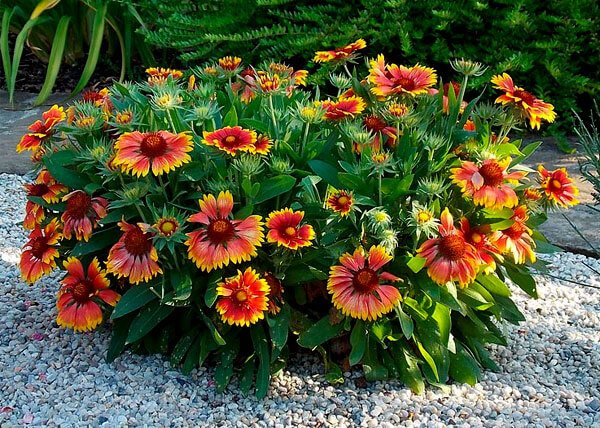

This plant is sometimes confused with helenium, in some varieties of which the color of the flower baskets is almost the same.
Read also: How to cook wheat porridge in milk
Many varieties of osteospermum are often called colored chamomile. Their inflorescences can combine a variety of shades: pink, white, red, lilac and others.
Here the photo shows tricolor osteospermum:
The abundance of color variations is also inherent in gazania. Its inflorescences are very large, and the petals are pointed. They can combine 3-4 color shades at once. The photos show some plant varieties:
Gazania and osteospermum are often grown not only outdoors, but also in pots. Thanks to their bright inflorescences and a long flowering period, they become a wonderful decoration for the home. You can grow these flowers both from seeds and by purchasing seedlings. Their prices are much higher than for seeds, however, according to reviews, they almost always take root well.
Venidium boasts even larger and brighter flower baskets. Their diameter ranges from 10 to 14 cm, and the height of the bushes can reach 80 cm. Reed flowers come with pointed or rounded edges. They come in white, yellow, orange, red and some other colors. At the same time, in almost all varieties, the middle is black, and around it, on the edge flowers, a ring of a contrasting color is outlined - brown, burgundy or purple.
A similar color is found in arctotis. Some varieties also form a ring of a different color around the core. Moreover, its petals are more pointed, and the diameter of the baskets is slightly smaller.
Here the photo shows the Venidium bushes:
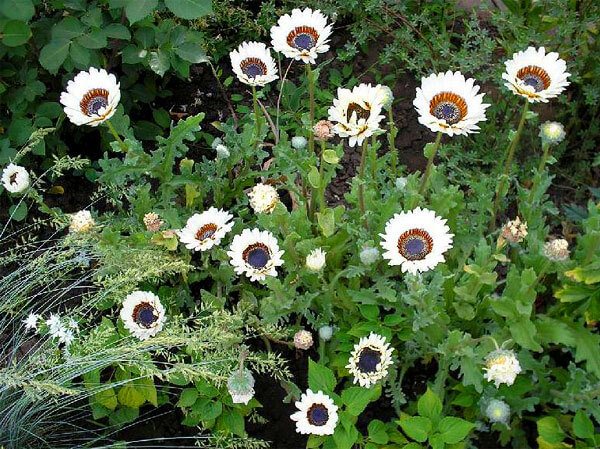

And here is the arctotis:
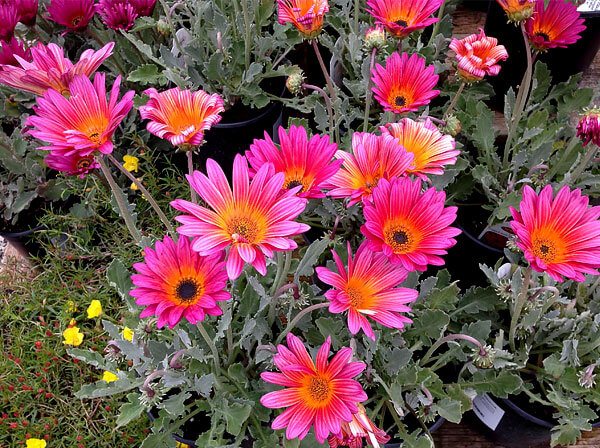

And this is ursinia umbilical:
As you can see from the photo, its marginal flowers are colored at the base in a rich brown color, which smoothly turns into burgundy, and then into bright orange.
Features of planting and crop care
Yellow chamomile is a rather unpretentious flower, it can be sown directly into the ground with seeds. In spring, sowing can be carried out from May, in autumn - in October. However, for reassurance for the first time, you can grow seedlings in this way:
- in February-March, seeds can be sown in the soil (universal, with the addition of sand, peat);
- monitor the lighting and regular watering of seedlings;
- when three leaves appear, you need to make a pick;
- in May, young flowers should have five leaves.
Field chamomile
Chamomile should be planted in places well-lit by the sun. The soil suitable for this plant should be slightly alkaline, loose. Make 20 cm depressions in the ground for each plant, then plant it by transshipment. Be sure to water.
Two weeks after planting, chamomile can be fed with mineral fertilizers. Further care is simple: watering, removing weeds, loosening the soil.Yellow chamomile is frost-resistant, but this is a property of mature plants. And for the young first two years for the winter, it is better to cover with additional dry grass, foliage.
Chamomile can be propagated by cuttings and rhizomes.
Important! It is necessary to separate mature bushes 5 years after planting so that the flowers do not become smaller in size. By dividing it into small bushes, the plant rejuvenates.
The division of the bush into several is carried out in the fall after flowering. A large bush is divided into equal parts along with the root. Then new bushes are transplanted into the prepared soil, top dressing is applied. Yellow chamomile can be propagated by cuttings, although this is a less common method.
Extra attention to the plant will benefit:
- timely removal of wilted flowers;
- regular watering and weeding;
- soil mulching is encouraged: in summer in a thin layer, in winter up to 20 cm.
Mulching protects flowers from overgrowth of weeds and drying out of the soil, retains moisture.
After the end of the growing season, the chamomile is cut off (all the ground part).
In order for the flowers to bloom for a long time and profusely, you need to feed them periodically:
- at the beginning of flowering, nitrophoska fertilizer is suitable;
- after flowering immediately with potassium and superphosphate;
- it is recommended to introduce ash into the soil, in the fall from pests.
Pink, red and other daisies
Since more than 30 thousand different plants belong to the Aster family, and the inflorescences of many of them have a similar structure, daisies are often called the most different and seemingly completely different flowers. For example:
- Anacyclus;
- Cosmey;
- Erigeron;
- Echinacea and many others.
Anacyclus is called pink chamomile. Its middle is yellow, and the marginal petals are pale pink, but on the back they are painted in a rich crimson color. Anacyclus bushes are very low, its stems grow up to only 10 cm. Thanks to these features, the plant is easy to identify. Cosmos flowers are visually familiar to many, since they are often planted on flower beds, but only specialists know its correct name. Cosmea inflorescences differ from chamomile not only in color, but also in size. Their petals are approximately 2-3 times wider. The color of tubular flowers in cosmos is usually yellow, and the marginal flowers are white, pink, purple or multi-colored.
Cosmos bushes look like this:
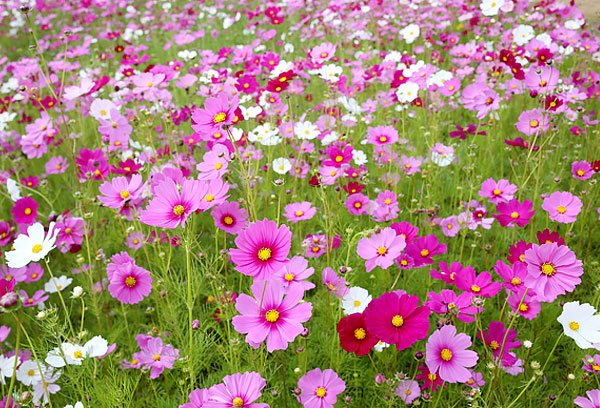

But this is a bush of phlox, with which cosme is sometimes confused:
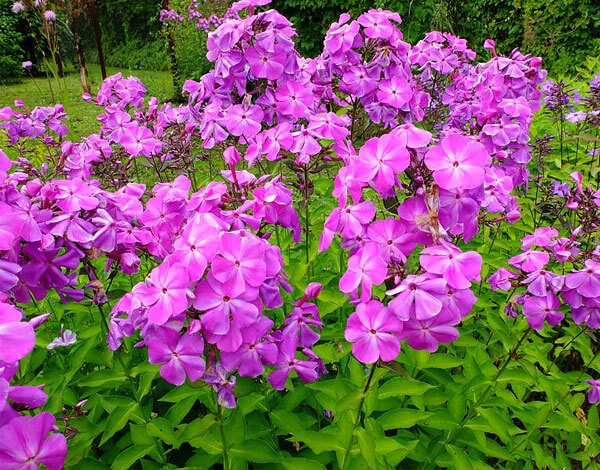

Erigeron is also mistakenly referred to as matrikarii. Moreover, the plants of this species have obvious differences. Their petals are very narrow and pointed, and on the inflorescences they are arranged in several rows. The color of flower baskets is completely different. They can combine white, yellow, lilac, burgundy, orange and other colors.
They look like chamomile and echinacea inflorescences. Most often they come in yellow, pink and lilac colors.
Adding an article to a new collection
In this article, we have collected for you the names and photos of the most common flowers that look like daisies.
If you are puzzling over the name of that big flower that looks like a daisy, we are in a hurry to help you! Check out our selection of plants that resemble this romantic, humble flower.
Pyrethrum
The flowers of this herbaceous perennial are actually very similar to chamomile. They are also often confused with the nivyanik. A distinctive feature of the plant is a lush core and brightly colored petals. Pyrethrum is known for its ability to repel harmful fleas, bedbugs, and other insects. Therefore, flower growers adore them. Most often, scarlet varieties flaunt on the flower beds.
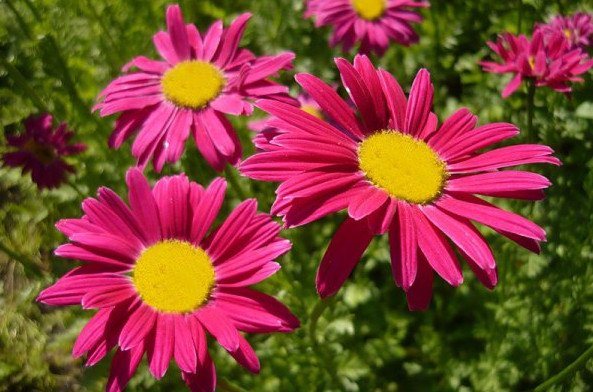

The culture has a medium-sized stem up to 60 cm tall, bright green pinnately dissected leaves and a small flower basket, up to 6 cm in diameter. The petals are smooth and ruled. There are raspberry, lilac, white, yellow and pink shades. Recently, breeders have delighted lovers of variegated, always blooming flower beds with rich terry varieties.
Did you know? Pyrethrum petals are widely used in households for the cultivation of a special powder from dry raw materials, which is used to treat fleas from livestock.
The culture is characterized by winter hardiness and unpretentiousness to growing conditions, but does not tolerate damp soils. Loves light and adapts well to partial shade.
Eastern Doronicum
Doronicum orientalis is a perennial plant. Due to the fact that its bushes bloom from early May to late June, it is sometimes called early or spring chamomile. You can recognize the doronicum by the wide carved foliage, which is located low above the ground, and erect stems, from 30 to 50 cm in height, with single yellow-golden inflorescences. Unlike true daisies, the marginal flowers of the doronicum are narrower and sharper.
It is also useful to read: How is chamomile tea useful for the body?
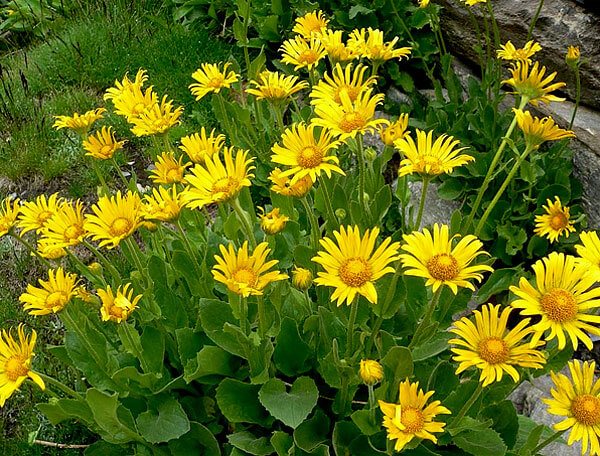

In the plantain doronicum, pedicels can grow up to 140 cm.Its inflorescences are also larger, their diameter is 12 cm.It blooms from mid-May to mid-June.
In gardens and in summer cottages, eastern doronicum is often grown. This is a more decorative look that can decorate any flower bed. It grows well on moist soil in lighted or semi-shaded places. Doronicum reproduces vegetatively. To plant it in new places, the shrub is dug up in the middle of summer, after flowering is over, divided into cuttings and planted.
On a note
Most aster plants grow well in the sun and in open areas. Doronicum is one of the few species that can also grow in forests and shady gardens, which is why it is sometimes called forest chamomile.
Exotic specimens
Tropical varieties, rare in Russian gardens, are not adapted for wintering and are grown as annuals. These include the following representatives of the flora:
- Osteospermum has another name - Cape daisy. The colors of the petals are varied - from the lightest to the darkest tones. The maximum basket size is 8 cm. There are hybrid flowers with spoon-like petals. They are called "spoon" osteospermums.
- A flower similar to a chamomile, the name of which is felicia. The unpretentious blue flower was brought to Europe from South Africa. From an agricultural standpoint, it is a tricky plant, but its unusual color, which reflects the heavenly blue, makes it more and more popular. Those wishing to admire blue flowers in their garden should be aware of the sensitivity of this culture to a lack of light.
- Ursinia is originally from the South African Republic. Not all varieties of this cultivated plant are suitable for Russian climatic conditions. The most adapted is dill ursinia. It is grown in garden plots only in the summer season. Its bright yellow petals are colored brown at the base, which gives the culture an attractive and unusual look. It takes a lot of sunlight to bloom well.
- Gatsania, or gazania, is another tropical plant. The stem is short, the petals have a rich color palette. The textured dark green leaves are very attractive. Can be grown as a perennial crop. In this case, for all winter months, the bushes are transferred to a room with good lighting.
- Arktotis - South African culture is represented by 70 varieties, the most famous of which are short-stemmed, lush, stemless, rough and hybrid plants. Leaves of various shapes, color of petals in delicate pastel tones. Some of them can be brightly colored. Undemanding to environmental conditions.
- Argirantemum is a colored species of chrysanthemums native to the Canary Islands. Evergreen plant 80-90 cm tall prefers places where mild climate prevails. In the middle lane it winters indoors, and with the onset of spring it is planted on terraces, in gardens, in summer cottages.
All chamomile plants require sunny areas. Many of them are attractive even in inclement weather. As for what kind of soil should be, experts recommend a well-drained soil. From the listed variety of cultures, flower growers can choose any variety based on their preferences in color, size and type.

